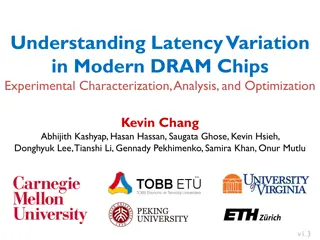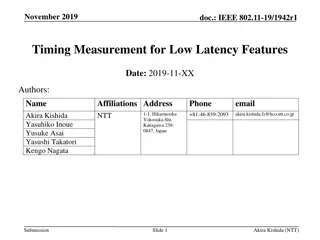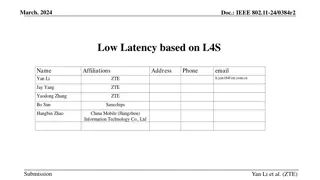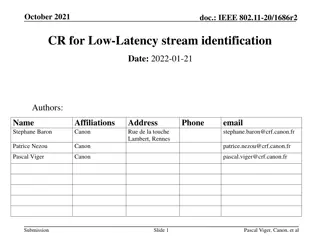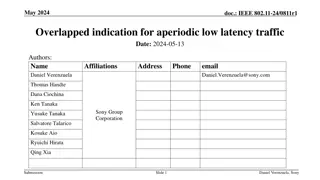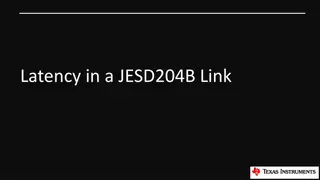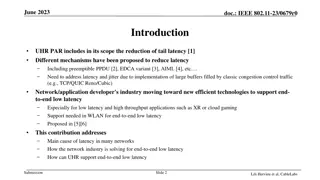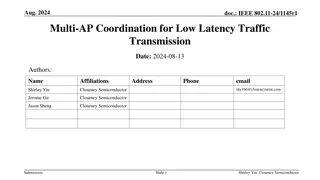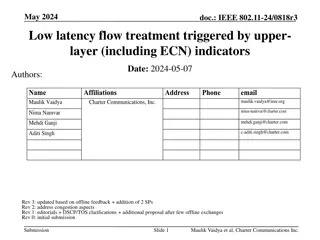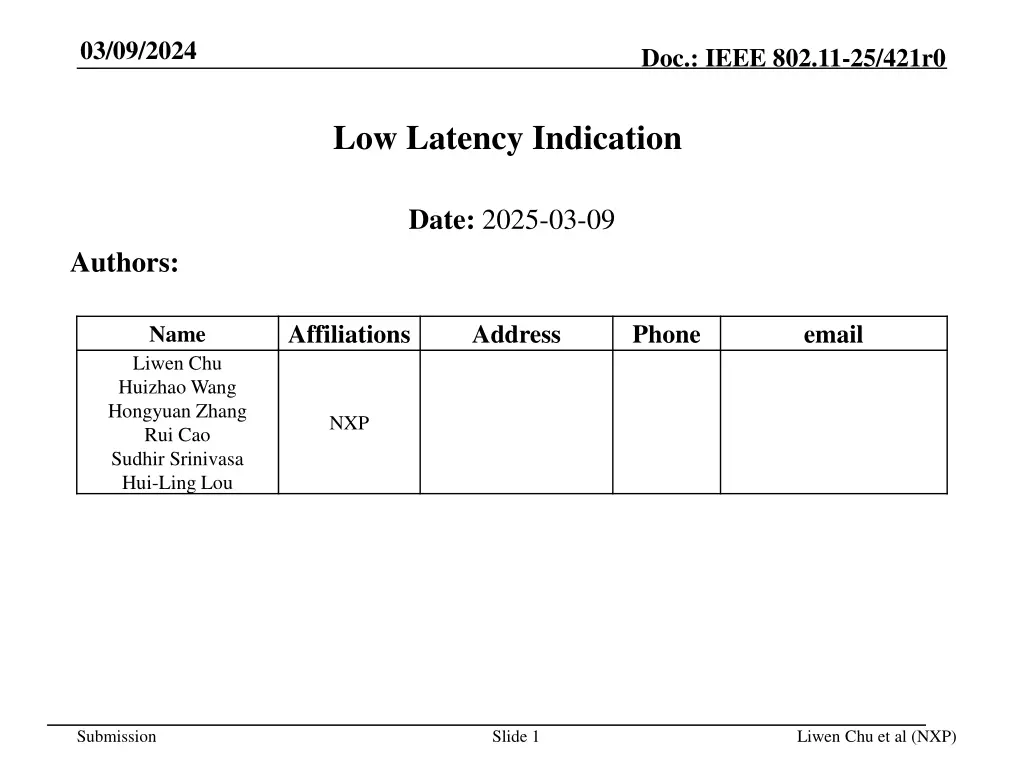
IEEE 802.11 Low Latency Indication Enhancement Proposal
"Explore the proposed enhancements for low latency indication in IEEE 802.11 standard, focusing on Multi-STA BA format and special Per AID TID fields for carrying time-sensitive information. Discover the intricate details of signaling low latency needs between non-AP STAs and TXOP holders in wireless communication networks."
Download Presentation

Please find below an Image/Link to download the presentation.
The content on the website is provided AS IS for your information and personal use only. It may not be sold, licensed, or shared on other websites without obtaining consent from the author. If you encounter any issues during the download, it is possible that the publisher has removed the file from their server.
You are allowed to download the files provided on this website for personal or commercial use, subject to the condition that they are used lawfully. All files are the property of their respective owners.
The content on the website is provided AS IS for your information and personal use only. It may not be sold, licensed, or shared on other websites without obtaining consent from the author.
E N D
Presentation Transcript
03/09/2024 Doc.: IEEE 802.11-25/421r0 Low Latency Indication Date: 2025-03-09 Authors: Affiliations Address Phone email Name Liwen Chu Huizhao Wang Hongyuan Zhang Rui Cao Sudhir Srinivasa Hui-Ling Lou NXP Submission Slide 1 Liwen Chu et al (NXP)
03/09/2024 Doc.: IEEE 802.11-25/421r0 Recap: Location Indication The group agreed the following low latency indication TGbn defines or improves an existing mechanism so that a non-AP STA that is a TXOP responder can indicate its buffered low latencyLL traffic needs (for traffic from the TxOP TXOP responder to the TxOP TXOP Holder) in a control response frame. The TXOP holder should consider the indication in determining subsequent actions. Subsequent actions related to this indication are out of the scope of the standard. Note: whether an AP can Indicate indicate its low latency needs is TBD [Motion #273, [264] and [288-300]] Submission Slide 2 Liwen Chu et al (NXP)
03/09/2024 Doc.: IEEE 802.11-25/421r0 ICF/ICR in 11bn 11bn decided to repurpose BSRP Trigger and Multi-STA BA for various features since BSRP Trigger and Multi-STA BA are flexible enough to carry the additional information Solicited unavailable time report for in-device coexistence. The Multi-STA BA is the response to carry the unavailable time in special Per AID TID Information field. unsolicited unavailable time report for in-device coexistence. The Multi-STA BA is the acknowledgement to BSRP Trigger carrying the unavailable time. No special Per AID TID Info field is needed. Responding frame for NPCA when non-HT duplicate PPDU needs to be used for the AP to carry the response. Submission Slide 3 Liwen Chu et al (NXP)
03/09/2024 Doc.: IEEE 802.11-25/421r0 Multi-STA BA Format For Unavailable Time Report The following special Per AID TID Indo field is used to carry the unavailable time: AID11 field equal to the same special value as the special Per AID TID Info field carrying unavailable information (Feedback Per AID TID Info field). The Low Latency Indication is included in the Feedback field of the Feedback Per AID TID Info field (the one that carries control feedback) The Feedback Type field (Located in B12 to B15 of the Block Ack Starting Sequence Control) is set to 1 Note: Feedback Type field set to 0 is used for DUO feedback. TBD bits in the Feedback field is defined to provide the low latency need. Submission Slide 4 Liwen Chu et al (NXP)
03/09/2024 Doc.: IEEE 802.11-25/421r0 Summary We proposed Multi-STA BA being used to carry LL need: AID11 field equal to the same special value as the AID11 field of Feedback Per AID TID Info field. The Low Latency Indication is included in the Feedback field of the Feedback Per AID TID Info field. The Type field is defined in Sequence Number field to differentiate the information being carried. Submission Slide 5 Liwen Chu et al (NXP)
03/09/2024 Doc.: IEEE 802.11-25/421r0 SP1 Do you agree to amend Motion #273 as following? TGbn defines or improves an existing mechanism so that a non-AP STA that is a TXOP responder can indicate its buffered low latencyLL traffic needs (for traffic from the TxOP TXOP responder to the TxOP TXOP Holder) in a control response frame. The TXOP holder should consider the indication in determining subsequent actions. Subsequent actions related to this indication are out of the scope of the standard. Note: whether an AP can Indicate indicate its low latency needs is TBD The Low Latency Indication is included in the Feedback field of the Feedback Per AID TID Info field (the one that carries control feedback). The Feedback Type field (Located in B12 to B15 of the Block Ack Starting Sequence Control) is set to 1 Note: Feedback Type field set to 0 is used for DUO feedback TBD bits in the Feedback field is defined to provide the low latency need. Submission Slide 6 Liwen Chu et al (NXP)








